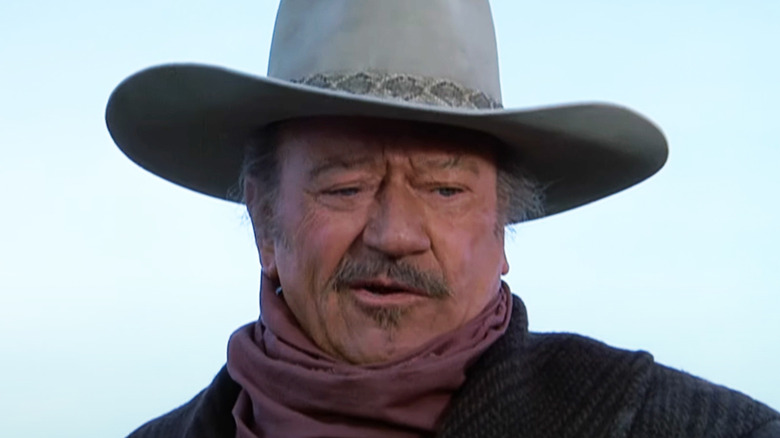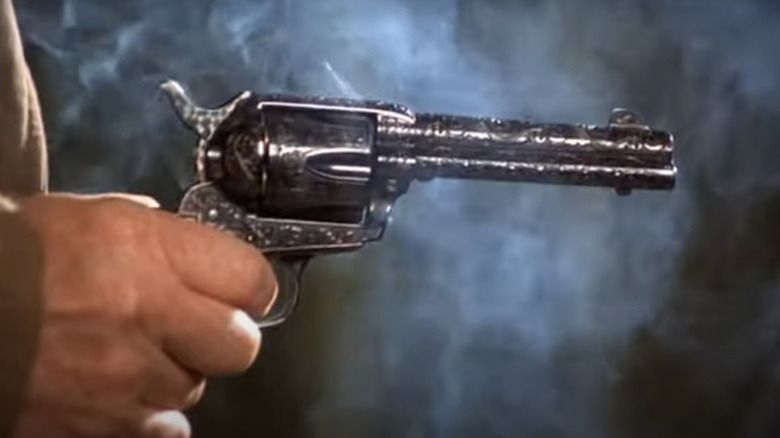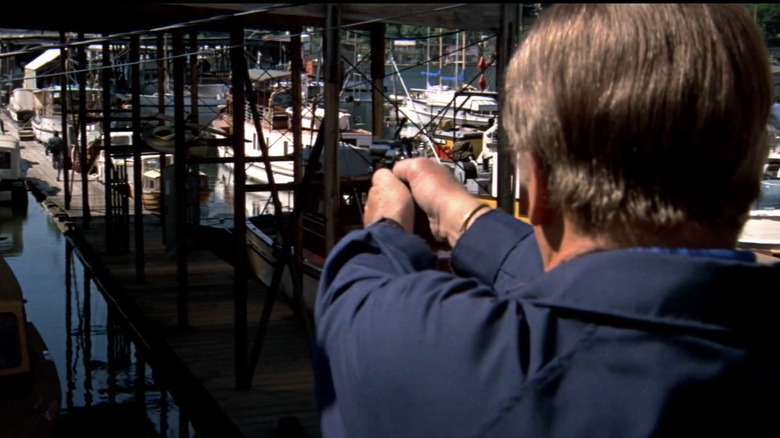John Wayne Broke One Of His Biggest Rules For This Movie
After John Wayne was cast in 1969's "True Grit," some strict rules were put in place on-set. Specifically, director Henry Hathaway established a set of guidelines that would ensure Wayne was left mostly unbothered by the cast and crew, most notably forbidding any discussion of politics at what was a fraught time for the U.S. These were hardly the first ever rules ever established when it came to John Wayne, however.
The Duke had plenty of personal rules, telling the BBC (via The Express) about which roles he would and wouldn't accept. Anything "mean and petty" was, for example, off the table, with Wayne adding, "I think I have established a character on the screen that may be rough, cruel, may have a different code than the average person, but it has never been mean or petty, small." That's a fair enough assessment of the man's own oeuvre, although some of the Duke's personal statements and views could easily be characterized as mean or petty (just read his infamous 1971 Playboy interview for a few handy examples).
Wayne also seemingly wasn't above handing over editorial control of his film "The Green Berets" to the government. Giving the government more control over anything at all surely must have been a bitter pill to swallow for a Republican, but at least he got to film on military bases. The veteran star was also seemingly willing to transgress one of his long-standing rules about his on-screen conduct later in his career, but would later get very upset when a seasoned director suggested he do it again.
Don Siegel tried to break a John Wayne rule and felt the wrath of the Duke
During his episode of "Inside the Actors Studio," Clint Eastwood told a story about how Don Siegel managed to upset the Duke while shooting 1976's "The Shootist." The film paired John Wayne with "Happy Days" star Ron Howard, and saw the former play an aging gunslinger who takes Howard's fatherless youngster under his wing. Wayne was already fighting a constant battle behind the scenes of "The Shootist," and it seems director Don Siegel — who had worked with Eastwood on five films including 1971's "Dirty Harry" and 1979's "Escape from Alcatraz" — made things worse with his suggestion that Wayne take a bad guy by surprise. "Don got in trouble when he was doing a film called 'The Shootist,'" recalled Eastwood, who went on to explain how one scene in particular stoked the Duke's ire:
"The villain sneaks around the room and John Wayne comes up behind him and [Siegel] says, 'Then you shoot him,' and there was a long pause and John Wayne said, 'You mean I shoot him in the back?' and [Siegel] says, 'Yeah, yeah you shoot him, just shoot him, get rid of him because you got four other guys in here.' [Wayne] said, 'I don't shoot anyone in the back.'"
According to Eastwood, Siegel had made "a terrible error" when he told Wayne "Clint Eastwood would have shot him in the back." As Eastwood remembered it, "Wayne turned blue and he said, 'I don't care what that kid would have done, I don't shoot him in the back.'" Wayne had already come into "The Shootist" with one major condition, namely that the film — which turned out to be his last — also double as a tribute to his longtime steed, Dollor. But it seems he also had several other conditions, not shooting people in the back included. The only problem was that he'd already broken this seemingly inflexible rule.
John Wayne broke his own rule
Despite his protestations against being compared to Clint Eastwood, John Wayne seemed at least somewhat amenable to emulating his fellow screen legend. Just two years before "The Shootist" debuted, Wayne starred in "McQ," a 1974 crime action feature from director John Sturges which came just three years after "Dirty" Harry Callahan first appeared on-screen and was a clear attempt to ape the style of that hugely successful (and controversial) Eastwood-starring crime thriller.
In "McQ," Wayne plays Seattle Detective Lieutenant Lon "McQ" McHugh who uncovers corruption in the police department after his partner is murdered. At one point, a hit man tracks down McQ and attempts to shoot him, only for Wayne's cop to dive out of the way behind some trash cans. McQ then rises and takes aim as the assassin runs away, landing a shot square between the shoulders and taking out his would-be murderer in true John Wayne style. Except, it wasn't really true John Wayne style according to the man himself.
This appears to be one instance where the Duke was more than happy to shoot a man in the back, so it can't have been all that strict a rule. Considering all the things Wayne was going through on "The Shootist," including having to hide his ailing health and ensuring he had a hefty insurance bill to pay, it might just be that he was feeling a tad combative at the time Don Siegel suggested shooting a man in the back. At least Old Hollywood came to Wayne's aid on "The Shootist," with old friends of the Duke showing up to set to help lift his mood. Telling him he should follow the example set by Clint Eastwood, however, was never going to help in that regard.


